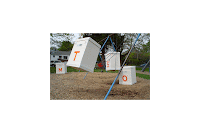I lead a class focusing on the idea of collaboration for the social practice critical theory independent study group.
The more I learn about negotiation (which is my elective this quarter), the more I am starting to think of each interaction we have as artists with the audience as a kind of negotiation. Negotiators are trying to “create value” for the other side and to persuade them into thinking about the issue at hand in a new way. So in theory, as artists, we can decide to have a collaborative style or competitive style or avoidant style with our audience, or with other artists, or with funding institutions. So, instead of thinking of negotiating as something a lawyer does, we might have fun seeing negotiation as something each of us does in every interaction we have with another person. I have been wondering what it would be like to try and match different artists with different conflict styles. Do painters negotiate with their audience in different ways than social praciticioners? If so, how?
For the class, I had people:
1. Take a Confict Styles test. We read through descriptions of five different conflict styles – competitive, avoidant, com promising, accomodating, and collaborative – and then tried to come up with examples of specific situations where different conflict styles would be helpful or not helpful. For example, we talked about how being competitive is helpful in a military or sport situation, but maybe onot in a situation where you want to build a relationship. We also talked about how this test is really only relevant to Western individualist cultures and not to people from Eastern Asian collectivist cultures, such as Thailand where Varinthorn is from.
promising, accomodating, and collaborative – and then tried to come up with examples of specific situations where different conflict styles would be helpful or not helpful. For example, we talked about how being competitive is helpful in a military or sport situation, but maybe onot in a situation where you want to build a relationship. We also talked about how this test is really only relevant to Western individualist cultures and not to people from Eastern Asian collectivist cultures, such as Thailand where Varinthorn is from.
2. After the discussion of conflict styles at a personal level, we moved into discussion around the Introduction from the book Collectivism After Modernism edited by Blake Stimson and Gregory Sholette. We reviewed how societal perception of collectivism has changed in America since World War 2 and also after 9/11. We talked about reasons why the American government (democrats and republicans) and the mass media might prefer the American population to have a competitive mindset, and what effects that has on our culture.
We also talked about what can happen when the artist collaborates with their audience or
with other artists. We how Varinthorn wonders if using the web and language of advertising in her work is not collaborative enough, and how maybe other parts of her work are collaborative.
I haven’t fully wrapped my head around these ideas, but feel like I am headed into rich territory. It is great having this opportunity to look at collaboration from historical, political, economic and conflict resolution lenses, and to then be able to bring this discussion back into the art realm.
Labels: collaboration



